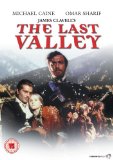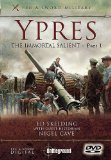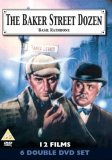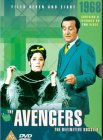![Boy Meets Girl - Series 1 & 2 Boxed Set [DVD]](/pictures/1140751.jpg) Boy Meets Girl - Series 1 & 2 Boxed Set | DVD | (22/08/2016)
from £N/A
| Saving you £N/A (N/A%)
| RRP
Boy Meets Girl - Series 1 & 2 Boxed Set | DVD | (22/08/2016)
from £N/A
| Saving you £N/A (N/A%)
| RRP All 12 episodes from the first two series of the British comedy drama starring Harry Hepple and Rebecca Root. When recently-fired 26-year-old Leo (Hepple) gets stood up on a blind date, he unexpectedly meets an interesting older woman called Judy (Root). The two have an immediate connection and arrange to meet up again, but how will Leo react when he discovers Judy's unusual secret?
![Clockwork Mice [1995]](/pictures/1019366.jpg) Clockwork Mice | DVD | (10/03/2003)
from £N/A
| Saving you £N/A (N/A%)
| RRP
Clockwork Mice | DVD | (10/03/2003)
from £N/A
| Saving you £N/A (N/A%)
| RRP The special relationship between a boy with a troubled past and a young teacher. Based on a screenplay by Rod Woodruff.
![Extremely Dangerous [DVD] [1999]](/pictures/1092362.jpg) Extremely Dangerous | DVD | (08/06/2009)
from £7.87
| Saving you £9.38 (141.91%)
| RRP
Extremely Dangerous | DVD | (08/06/2009)
from £7.87
| Saving you £9.38 (141.91%)
| RRP Wrongfully convicted for the murder of his wife and child Neil Byrne (Sean Bean) manages to elude his guards en route to prison when he jumps off a moving train. Byrne goes undercover in Manchester becoming involved with a crime syndicate as he struggles to prove his innocence uncovering several dark secrets in the process.
 The Last Valley | DVD | (01/01/2008)
from £13.13
| Saving you £-7.14 (N/A%)
| RRP
The Last Valley | DVD | (01/01/2008)
from £13.13
| Saving you £-7.14 (N/A%)
| RRP In his nomadic travels, Vogel (Omar Sharif) comes across a beautiful, peaceful village where the community lies unaffected by the war raging around it. Here, he is given the opportunity to lodge there for the winter in return for protection. When an army of ruthless mercenaries led by 'The Captain' (Michael Caine) also discover the oasis, the peace is shattered and the village descends into conflict and violence.
![The League Of Gentlemen [1960]](/pictures/1013192.jpg) The League Of Gentlemen | DVD | (15/01/2001)
from £14.98
| Saving you £0.01 (0.07%)
| RRP
The League Of Gentlemen | DVD | (15/01/2001)
from £14.98
| Saving you £0.01 (0.07%)
| RRP The League of Gentlemen is a sardonic crime drama in which Jack Hawkins plays an embittered retired army officer who recruits seven fellow ex-soldiers to carry out a bank raid with military precision. The film presents an England between post-war austerity and the more liberated 1960s where traditional moral certainties were rapidly being discarded; a London where ex-officers left on the scrapheap at war's end could justify turning their military experience to armed robbery. Unfortunately the tale is neither particularly amusing or thrilling, with an overlong central detour via an army camp prefacing the exciting heist and a largely anti-climactic ending. Nevertheless Hawkins effectively subverts his heroic officer type from The Cruel Sea (1953) and The Bridge on the River Kwai (1957), and there's excellent support from a great cast including Nigel Patrick, Richard Attenborough and Roger Livesey. Bryan Forbes not only wrote the cynical screenplay but costarred with wife Nanette Newman in her first significant screen role. More influential than truly classic, The League of Gentlemen has lent its name to a modern BBC comedy, an "Extraordinary" comic strip-turned-movie, and proved the template for heist films ever since, including both versions of The Italian Job (1969 and 2003). On the DVD:The League of Gentlemen is presented in an anamorphically enhanced 16:9 transfer from an excellent condition print and mostly looks and sounds fine. There's minimal print damage, though sadly Philip Green's ironically patriotic main title music suffers from significant distortion. The only extra is the original trailer, which is now something of a period piece itself. --Gary S Dalkin
 Suspicion | DVD | (21/04/2003)
from £N/A
| Saving you £N/A (N/A%)
| RRP
Suspicion | DVD | (21/04/2003)
from £N/A
| Saving you £N/A (N/A%)
| RRP Repeated viewings can't dispel the shock of the final scene of Suspicion, Hitchcock's classic 1941 romantic mystery--a brief but disorientating confrontation that suddenly inverts the heroine's mounting conviction that she's married a murderer, forcing us to reconsider virtually every scene and line of dialogue that's preceded it. It's a masterful coup de grâce for the director, who has built a puzzle around the corrosive power of suspicion, threaded with deft ambiguities that toy with dramatic conventions and character archetypes in nearly every frame. As embodied by Joan Fontaine, who nabbed an Oscar in this second outing with the director, Lina McLaidlaw is a buttoned-up, bookish heiress whose prim exterior conceals longings for a more engaged emotional life. Her solution materialises in the darkly handsome Johnnie Aysgarth, a gambler, womaniser and spendthrift who flirts, then pursues, and soon marries her. As Aysgarth, Cary Grant is both irresistible and sinister, capable of deceit and petty theft, as well as grander designs on his bride's impending fortune. Lina's passion for Johnnie is clouded by each new revelation about his apparent dishonesty, from clandestine gambling to real-estate development schemes; more troubling are clues implicating him in the death of his best friend, and the prospect that Johnnie may be slowly poisoning Lina herself. By the time we see him ascending a darkened staircase with a suspicious glass of milk, an image made all the more indelible through the spectral glow the director captures in the glass, the evidence seems damning indeed. In fact, even as Hitchcock stacks the deck against Johnnie, and takes full advantage of Grant's skill at conveying such menace, the director also dots his landscape with visual clues to Lina's own neurotic (and erotic) obsessions. The final scene forces us to re-evaluate her behaviour while leaving enough of a cloud over Johnnie to rob him, and us, of a complete exoneration. It's a wicked, unsettling payoff to a brilliantly executed thriller. --Sam Sutherland
![Radiohead - Meeting People Is Easy [1998]](/pictures/1027660.jpg) Radiohead - Meeting People Is Easy | DVD | (04/09/2000)
from £N/A
| Saving you £N/A (N/A%)
| RRP
Radiohead - Meeting People Is Easy | DVD | (04/09/2000)
from £N/A
| Saving you £N/A (N/A%)
| RRP Shot on 35mm 16mm and DVC 'Meeting People Is Easy' is described by director Grant Gee as a documentary and multimedia scrapbook. The film follows the most successful yet enigmatic band of the past few years through their hectic touring and personal schedules over 1998 and 1999. Comprising of intimate interviews concert and behind-the-scenes footage of the band's extensive work pattern the documentary ultimately reveals the exhilaration and tribulation worldwide adoration can b
 Ypres-The Immortal Salient Part 1 | DVD | (21/04/2011)
from £11.95
| Saving you £3.04 (25.44%)
| RRP
Ypres-The Immortal Salient Part 1 | DVD | (21/04/2011)
from £11.95
| Saving you £3.04 (25.44%)
| RRP This film is presented by historian and film-maker Ed Skelding who takes us on a chronological journey through the first two years of fighting in the salient. He is joined by renowned military historian and author Nigel Cave who will join Ed at some key locations where decisive actions took place. Nigel is well known for his contributions to the Battleground Europe series of guide books published by Pen & Sword. This film will feature locations associated with the first two battles of Ypres, including Hooge Chateau, Langemark and Gheluvelt where the first encounters between the opposing armies took place. The story of the 1914 Christmas truce will be explained by Nigel and the nearby locations where the artist Bruce Bairnsfather drew the cartoons that were to establish the character of Old Bill. Nigel is also interviewed at the notorious location of Hill 60, where he reads from his Battleground Europe book, and explains why this was such a dreaded place, even for the Salient. The second part of this film then switches to the Second Battle of Ypres in April 1915. This became notorious for the first real gas attack of the war and was to change the attitude of the British soldiers towards the Germans. Gone forever was any notion of chivalry. Nigel is interviewed at Vancouver Corner - where an impressive memorial to the Canadians who died defending the line despite suffering many casualties from the gas – now stands. He also takes us to the nearby Totemuhle or Death Windmill to explain where the gas attack came from and the resulting lost opportunity for the Germans. This film will also tell the story of the Royal Army Medical Corps and the doctors who did so much often in the most desperate circumstances. Nigel is interviewed at Essex Farm, forever to be associated and immortalized by the poem of the Canadian Colonel John McCrae – In Flanders Fields.
 2 Point 4 Children - Series 1 To 3 | DVD | (22/09/2008)
from £N/A
| Saving you £N/A (N/A%)
| RRP
2 Point 4 Children - Series 1 To 3 | DVD | (22/09/2008)
from £N/A
| Saving you £N/A (N/A%)
| RRP On the surface the Porters are a normal family - indeed even the series' title 2 Point 4 Children the fabled average family size alludes to their normality (as well as the fact that the husband/father is still a bit of a child himself). Yet though the individual members - central-heating engineer Ben; his wife catering worker Bill; and their teenage children David and Jenny - are unexceptional the situations in which the family find themselves are anything but. Bad luck strang
![Sherlock Holmes: The Basil Rathbone Collection [DVD] [2021]](/pictures/1154593.jpg) Sherlock Holmes: The Basil Rathbone Collection | DVD | (19/04/2021)
from £18.75
| Saving you £N/A (N/A%)
| RRP
Sherlock Holmes: The Basil Rathbone Collection | DVD | (19/04/2021)
from £18.75
| Saving you £N/A (N/A%)
| RRP A writen and film tribute to Sherlock Holmes which includes four classic films from The Basil Rathbone Collection.
![Young Wives' Tale [DVD]](/pictures/1157297.jpg) Young Wives' Tale | DVD | (05/07/2021)
from £9.19
| Saving you £N/A (N/A%)
| RRP
Young Wives' Tale | DVD | (05/07/2021)
from £9.19
| Saving you £N/A (N/A%)
| RRP Joan Greenwood reprises her hit stage performance as a frustrated housewife in the film adaptation of this popular West End farce. Co-starring Nigel Patrick and Derek Farr and showcasing a memorable early performance from Audrey Hepburn Young Wives' Tale is featured here as a brand-new remaster from original film elements in its original theatrical aspect ratio. Compelled to live together due to the post-war housing shortage, the Pennants and the Bannings just about get along... but add in a brace of babies, a succession of nannies and a shy-but-pretty lodger, and the situation very soon starts to unravel! Special Features: Image gallery Limited edition booklet written by Melanie Williams
![Feardotcom [2003]](/pictures/1020969.jpg) Feardotcom | DVD | (29/09/2003)
from £4.90
| Saving you £15.09 (307.96%)
| RRP
Feardotcom | DVD | (29/09/2003)
from £4.90
| Saving you £15.09 (307.96%)
| RRP Four bodies are found in New York City and they all died 48 hours after logging on to a site named fear.com....
 Miles Davis The Definitive Miles Davis At Montreux DVD Collection 1973-1991 | DVD | (24/10/2011)
from £82.87
| Saving you £39.38 (48.25%)
| RRP
Miles Davis The Definitive Miles Davis At Montreux DVD Collection 1973-1991 | DVD | (24/10/2011)
from £82.87
| Saving you £39.38 (48.25%)
| RRP This historically important 10 DVD set captures all of Miles Davis’ performances at the renowned Montreux Jazz Festival between 1973 and 1991, the last being less than three months before his death. It is an unparalleled archive of live Miles Davis performances and is now being released on a visual format for the first time ever. Although many tracks are repeated across the years the concerts are strikingly individual with extensive improvisation and frequent rearrangements. The final concert from 1991 sees Miles Davis paying tribute to his collaborator and close find Gil Evans who had died in 1988. With Miles’ philosophy of “never look back” it was extraordinary that he would agree to perform such a show and it was a truly unique occasion captured here for posterity. Miles Davis is undeniably one of the most important and successful jazz figures of the 20th century. This unrivalled DVD box set of his live performances at Montreux is a release to be truly cherished. Bonus Features On disc one there are full interviews with Claude Nobs, Carlos Santana and Herbie Hancock plus shorter interviews about Miles Davis with Monty Alexander, Helen Merrill, Betty Carter, Charlie Haden, Gil Goldstein, Stanley Clarke, Jean Luc Ponty and Al Di Meola and Michel Petrucciani.
 Sherlock Holmes - Baker Street Dozen | DVD | (28/11/2005)
from £14.55
| Saving you £10.44 (71.75%)
| RRP
Sherlock Holmes - Baker Street Dozen | DVD | (28/11/2005)
from £14.55
| Saving you £10.44 (71.75%)
| RRP This six disc box-set brings together the most memorable twelve titles from the most famous actor to ever walk the footsteps of Sherlock Holmes. The feature films included in this collection are: House Of Fear (1945): Sherlock Holmes ever abetted by the trusty Watson investigates a series of deaths at a castle with each foretold by the delivery of orange pips to the victims... The Scarlet Claw (1944): Holmes and Watson investigate the death of Lady Penrose of La M
![Grand National Night (1953) [DVD]](/pictures/1117408.jpg) Grand National Night (1953) | DVD | (10/09/2012)
from £12.99
| Saving you £N/A (N/A%)
| RRP
Grand National Night (1953) | DVD | (10/09/2012)
from £12.99
| Saving you £N/A (N/A%)
| RRP A murder mystery without peer. Gerald Coates is a simple man with a reckless and glamorous wife. After throwing one of her usual tantrums she disappears until her body is found in an abandoned car.
 The Sherlock Holmes Catalogue - The Golden Pince-Nez / The Red Circle | DVD | (28/04/2003)
from £N/A
| Saving you £N/A (N/A%)
| RRP
The Sherlock Holmes Catalogue - The Golden Pince-Nez / The Red Circle | DVD | (28/04/2003)
from £N/A
| Saving you £N/A (N/A%)
| RRP Two enthralling investigations from Sherlock Holmes.
![A Killer Next Door [DVD] [2021]](/pictures/1154303.jpg) A Killer Next Door | DVD | (15/03/2021)
from £4.94
| Saving you £N/A (N/A%)
| RRP
A Killer Next Door | DVD | (15/03/2021)
from £4.94
| Saving you £N/A (N/A%)
| RRP Based on the true story of John List, who killed his wife, mother and three children in their home in New Jersey then disappeared without trace. Eighteen years later, in a small town in Virginia, Stephanie Hancock is confined to her home recovering from a broken leg. To pass the time she spies on her neighbours and begins to suspect that one of them, Bob Clark, is actually John List.
![Eagle Has Landed, The / The Ipcress File [1977]](/pictures/1002737.jpg) Eagle Has Landed, The / The Ipcress File | DVD | (17/03/2003)
from £N/A
| Saving you £N/A (N/A%)
| RRP
Eagle Has Landed, The / The Ipcress File | DVD | (17/03/2003)
from £N/A
| Saving you £N/A (N/A%)
| RRP In the spy-crazed film world of the 1960s, Len Deighton's antihero Harry Palmer burst onto the scene as an antidote to the James Bond films. Here was a British spy who had a working-class accent and horn-rimmed glasses and above all really didn't want to be a spy in the first place. As portrayed by Michael Caine, Palmer was the perfect antithesis to Sean Connery's 007. Unlike that of his globetrotting spy cousin, Palmer's beat is cold, rainy, dreary London, where he spends his days and nights in unheated flats spying on subversives. He does charm one lady, but she's no Pussy Galore, just a civil servant he works with, sent to keep an eye on him. Eventually he's assigned to get to the bottom of the kidnapping and subsequent "brain draining" of a nuclear physicist, all the while being reminded by his superiors that it's this or prison. Things begin to get pretty hairy for Harry. Produced by Harry Saltzman in his spare time between Bond movies, the film also features a haunting score by another Bond veteran, composer John Barry. --Kristian St. Clair, Amazon.com
 The Avengers : The Definitive Dossier 1968 (Box Set 4) | DVD | (10/03/2003)
from £N/A
| Saving you £N/A (N/A%)
| RRP
The Avengers : The Definitive Dossier 1968 (Box Set 4) | DVD | (10/03/2003)
from £N/A
| Saving you £N/A (N/A%)
| RRP The final adventures of the oh so dapper John Steed and his sidekick Tara King. Episode titles include: Fog Who Was That Man I Saw You With Pandora Thingumajig Homicide And Old Lace Requiem Take-Over Bizarre
![Checkmate [DVD]](/pictures/1147842.jpg) Checkmate | DVD | (29/10/2018)
from £9.65
| Saving you £N/A (N/A%)
| RRP
Checkmate | DVD | (29/10/2018)
from £9.65
| Saving you £N/A (N/A%)
| RRP Six people are thrown together during an elaborate bank heist where any move can alter the outcome. Is it coincidence, or are they merely pawns in a much bigger game.

Please wait. Loading...
This site uses cookies.
More details in our privacy policy